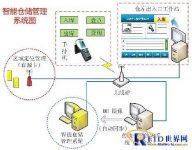
Automatic inventory and identification system solution based on RFID storage
[ad_1]
1. Overview of automatic inventory and identification system based on RFID warehousing
The intelligent warehouse management system based on RFID technology provides the original warehouse management system with reliable inventory information verification and fast positioning and searching functions for objects or people through remote automatic identification and inventory real-time information of in and out of the warehouse, enhancing the real-time warehouse Sexual management and anti-theft capabilities.
2. Scope of application
Warehouse, logistics items
Shopping malls, supermarket goods
Hospital equipment and medical waste
Factory production and assembly
Library management
Other places where products need to be classified and managed
3. Features
Automatic record of access information
Real-time inventory information management
Simultaneous reading and management of multiple tags
Improve efficiency and reduce labor costs
Instant anti-theft alarm notification function (such as SMS, sound and light alarm)
Item positioning is possible
Can carry out item misplacement alarm
Can automatically synchronize the original system data
Upgradable anti-theft system with dual cards for personnel and goods
Can build or customize the warehouse management system according to user needs, etc.
4. Based on the RFID warehouse automatic inventory and identification system icon

5. Based on the advantages of RFID warehousing automatic inventory and identification system
At present, the traditional warehouse management system uses barcodes for classification and identification. Compared with the RFID intelligent warehouse management system, the advantages are very obvious:
(1) Fast scanning: Traditional barcodes can only be scanned one barcode at a time; RFID readers can identify and read several RFID tags at the same time.
(2) Small size and diversified shapes: RFID does not need to match the fixed size and printing quality of paper for reading accuracy. It is more suitable for the development of miniaturization and diversified forms to facilitate embedding or attaching to different shapes and types On the product.
(3) Anti-pollution ability and durability: The carrier of traditional bar codes is paper, so it is easy to be contaminated, but RFID has strong resistance to substances such as water, oil and chemicals. In addition, because the barcode is attached to the plastic bag or the outer packaging carton, it is particularly vulnerable to breakage; the RFID tag stores the data in the chip, so it can be protected from contamination.
(4) Reusable: The current bar code cannot be changed after it is printed. The data stored in the RFID tag can be dynamically updated, and it can be recycled and used multiple times.
(5) Penetration and barrier-free reading: The bar code scanner must be at a close distance and there is no object blocking the situation before it can read the bar code. RFID can penetrate non-metallic and non-transparent materials such as paper, wood, and plastics for penetrating communication. It does not require a light source and has a longer reading distance. But it does not recognize through conductive objects such as metals.
(6) Data memory capacity: the capacity of one-dimensional barcode is 50Bytes, the maximum capacity of two-dimensional barcode can store 2 to 3000 characters, and the maximum capacity of RFID is MegaBytes. With the development of memory carriers, the data capacity also has a trend of continuous expansion. In the future, the amount of information that items need to carry will become larger and larger, and the demand for tags that can expand the capacity will increase accordingly.
(7) Security: Since RFID carries electronic information, its data content can be protected by a password, so that its content is not easy to be forged and altered, with higher security.
[ad_2]



